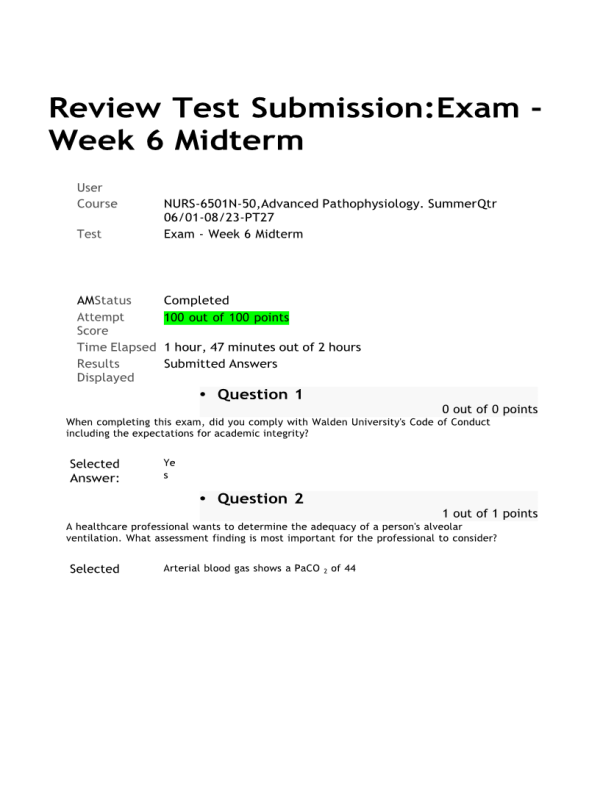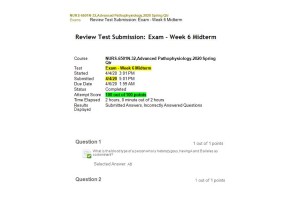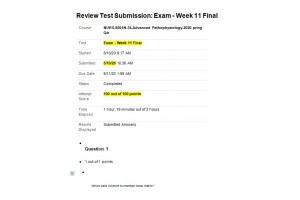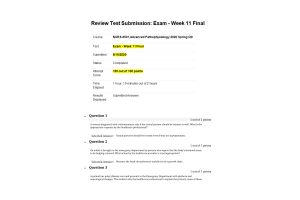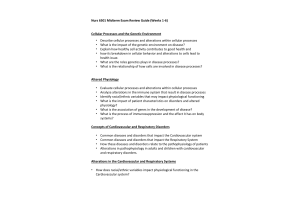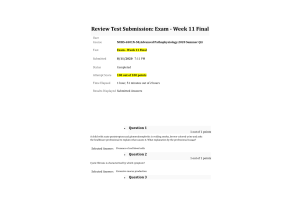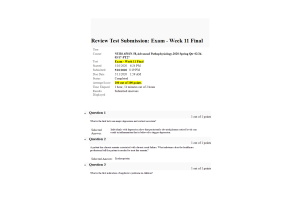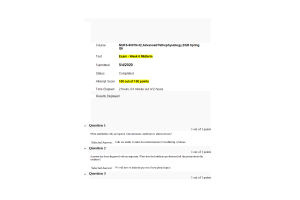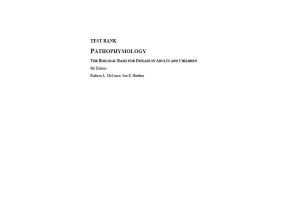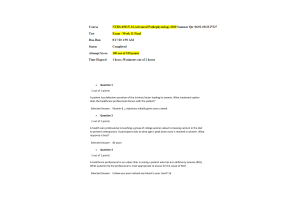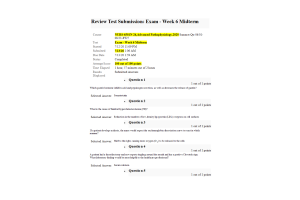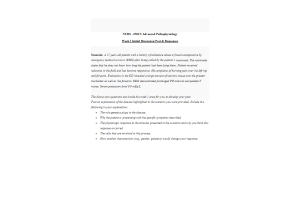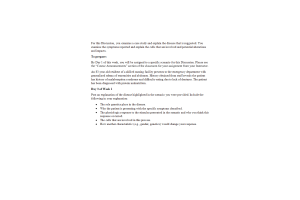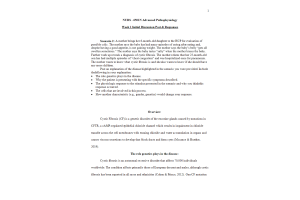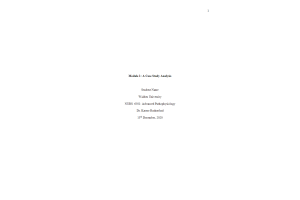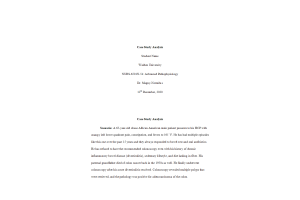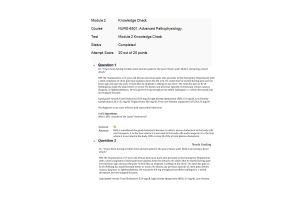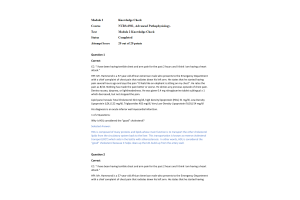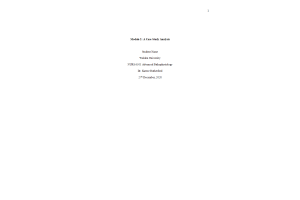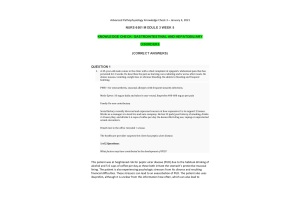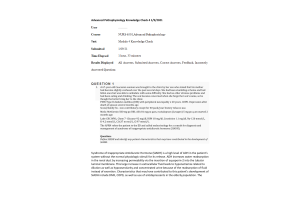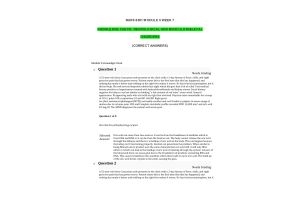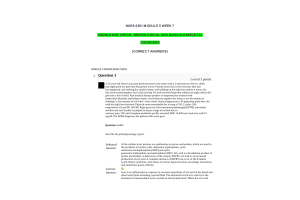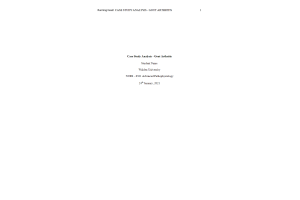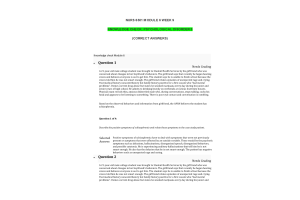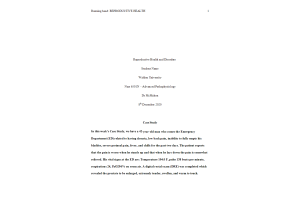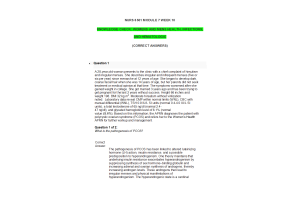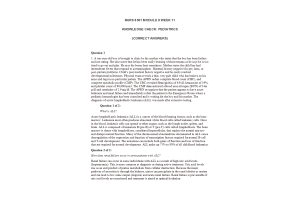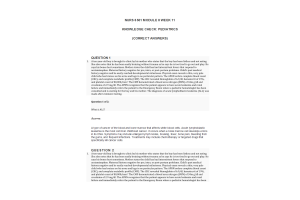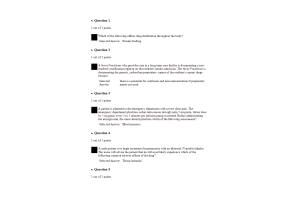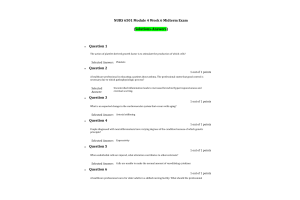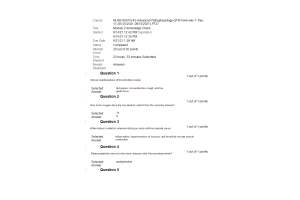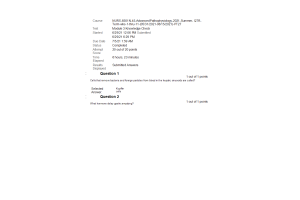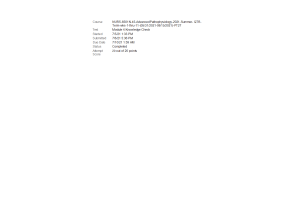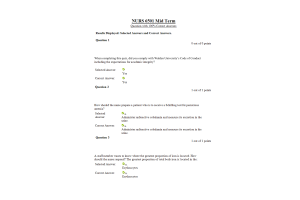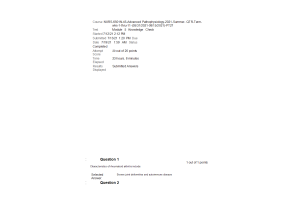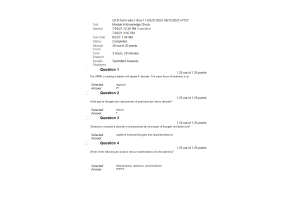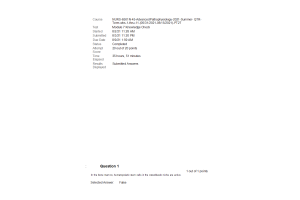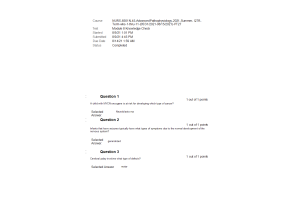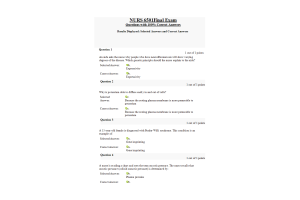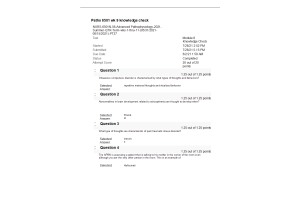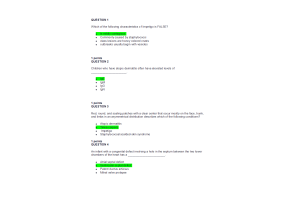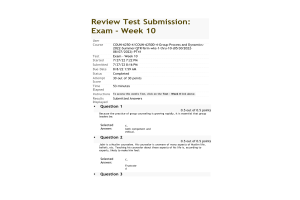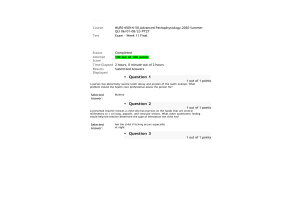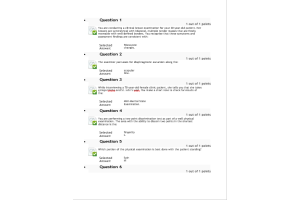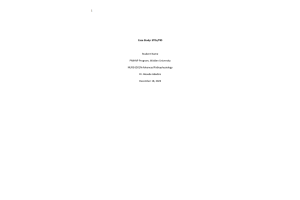NURS 6501N-50, Advanced Pathophysiology, Week 6 Midterm ExamScore; 100 out of 100 Points
- $55.00
- Question: When completing this exam, did you comply with Walden University's Code of Conduct including the expectations for academic integrity?
- Question: A healthcare professional wants to determine the adequacy of a person's alveolar ventilation. What assessment finding is most important for the professional to consider?
- Question: The healthcare professional explains to a student that the amount of volume of blood in the heart is directly related to the of contraction.
- Question: A parent wants to know how to prevent type 1 diabetes in the newborn. The healthcare professional explains that prevention is not possible, because which of these is a major characteristic of type 1 diabetes mellitus?
- Question: The pathophysiologic process of edema is related to which mechanism?
- Question: What is the blood type of a person who is heterozygous, having A and B alleles as codominant?
- Question: The Bainbridge reflex is thought to be initiated by sensory neurons in which cardiac location?
- Question: Under anaerobic conditions, what process provides energy for the cell?
- Question: What is the single most common cause of cellular injury?
- Question: A patient is in severe shock and is receiving vasopressin. A student asks the health care professional to explain the rationale for this treatment. What response by the professional is most accurate?
- Question: What part of the kidney controls renal blood flow, glomerular filtration, and renin secretion?
- Question: In regulating vascular mediators released from mast cells, the role of eosinophils is to release what?
- Question: A student studying biology asks the professor to describe how the ras gene is involved in cancer proliferation. What explanation by the professor is best?
- Question: A healthcare professional is caring for a patient who has a delay in electrical activity reaching the ventricle as seen on ECG. What ECG finding would the healthcare professional associate with this problem?
- Question: A healthcare professional is assessing a child who has complete trisomy of the twenty- first chromosome. What findings does the professional relate to this condition?
- Question: What is an expected change in the cardiovascular system that occurs with aging?
- Question: Which statement is true about phagocytosis?
- Question: What is the role of reverse transcriptase in HIV infection?
- Question: A healthcare professional is caring for four patients. Which patient does the professional assess for neurogenic diabetes insipidus (DI)?
- Question: After a partial gastrectomy, gastric bypass, or pyloroplasty, clinical manifestations that include increased pulse, hypotension, weakness, pallor, sweating, and dizziness are the results of which mechanism?
- Question: Which renal change is found in older adults?
- Question: Vaccinations are able to provide protection against certain microorganisms because of what?
- Question: A healthcare professional is educating a patient on asthma. The professional tells the patient that the most successful treatment for chronic asthma begins with which action?
- Question: A person wants to know if eating only plant-based foods is advisable as a way to cut cholesterol to near-zero levels. What response by the health care professional is best?
- Question: The student asks the professor to explain what characteristic is demonstrated by lungs with decreased compliance?
- Question: A student asks why carbon monoxide causes tissue damage. What response by the professor is best?
- Question: A patient reports dumping syndrome after a partial gastrectomy. What does the healthcare professional teach this patient?
- Question: A healthcare professional is caring for four patients. Which patient does the professional assess for pulmonary emboli (PE) as the priority?
- Question: A patient's urinalysis came back positive for glucose. What does the healthcare professional expect the patient's blood glucose to be at a minimum?
- Question: A professor has taught the students about the pathogenesis of abdominal pain. Which statement by a student indicates the professor needs to review the material?
- Question: A patient had a thyroidectomy and now reports tingling around the mouth and has a positive Chvostek sign. What laboratory finding would be most helpful to the healthcare professional?
- Question: Which cardiac chambers have the thinnest wall and why?
- Question: A class of students has learned about contributing factors to duodenal ulcers. What statement indicates to the professor that the students need a review?
- Question: Which term is used to identify the movement of gas and air into and out of the lungs?
- Question: A person has hypothyroidism. What chemical does the healthcare professional advise the person to include in the diet?
- Question: The mammary glands enlarge during pregnancy primarily as a consequence of what hormonal process?
- Question: A patient has a peptic ulcer related to h. pylori bacteria. What treatment does the healthcare professional educate the patient on?
- Question: The student wants information about a patient's renal function. What test does the healthcare professional tell the student to evaluate?
- Question: What are blood pressure variations associated with?
- Question: A student asks the healthcare professional to describe exotoxins. Which statement by the professional is best?
- Question: Which characteristic is the most important determinant of immunogenicity when considering the antigen?
- Question: What is the cause of functional dysphagia?
- Question: Which cAMP-mediated response is related to antidiuretic hormone?
- Question: A patient is brought to the Emergency Department with a gunshot wound to the chest. The healthcare professional assesses an abnormality involving a pleural rupture that acts as a one-way valve, permitting air to enter on inspiration but preventing its escape by closing during expiration. What action by the healthcare professional is the priority?
- Question: The data reporting that sickle cell disease affects approximately 1 in 600 American blacks is an example of which concept?
- Question: A patient suffered multiple traumatic injuries and received many blood transfusions within a few days of the injuries. For which medical condition should the healthcare professional monitor the patient for?
- Question: A patient has a pulmonary capillary wedge pressure of 30mmHg. What assessment finding by the healthcare professional would be most consistent with this reading?
- Question: A student asks the professor how a faulty negative-feedback mechanism results in a hormonal imbalance. What response by the professor is best?
- Question: An amniocentesis indicates a neural tube defect when an increase in which protein is evident?
- Question: A patient has been admitted for a possible small intestinal obstruction. What is the first sign the healthcare professional assesses for that would indicate the presence of this condition?
- Question: Which patient would the healthcare professional assess for other signs of thyrotoxic crisis?
- Question: Which statement made by a student indicates the healthcare professional needs to describe the pericardium again?
- Question: What does vomiting-induced metabolic alkalosis cause?
- Question: Oxygenated blood flows through which vessel?
- Question: In teaching a women's community group, which risk factor does the healthcare professional teach is related to high morbidity of cancer of the colon, uterus, and kidney?
- Question: Phagocytosis involves neutrophils actively attacking, engulfing, and destroying which microorganisms?
- Question: Which type of immunity is produced by an individual after either natural exposure to the antigen or after immunization against the antigen?
- Question: A Rh-negative woman gave birth to a Rh-positive baby. When discussing Rho[D] immunoglobulin with her, what information should the healthcare professional provide?
- Question: Surfactant produced by type II alveolar cells facilitates alveolar distention and ventilation by which mechanism?
- Question: The acute inflammatory response is characterized by fever that is produced by the hypothalamus being affected by what?
- Question: What is the major determinant of the resistance that blood encounters as it flows through the systemic circulation?
- Question: A patient is having a spirometry measurement done and asks the healthcare professional to explain this test. What response by the professional is best?
- Question: Within a physiologic range, what does an increase in left ventricular end-diastolic volume (preload) result in?
- Question: Pressure in the left ventricle must exceed pressure in which structure before the left ventricle can eject blood?
- Question: A patient has portal hypertension-induced splenomegaly. Which lab value would the healthcare professional associate with this condition?
- Question: Which hormone is required for water to be reabsorbed in the distal tubule and collecting duct?
- Question: The cardiac electrical impulse normally begins spontaneously in the sinoatrial (SA) node because of what reason?
- Question: A student asks about the mechanism that results in type II hypersensitivity reactions. What description by the professor is best?
- Question: Where is two thirds of the body's water found?
- Question: What pathologic change occurs to the kidney's glomeruli as a result of hypertension?
- Question: What is the cause of familial hypercholesterolemia (FH)?
- Question: When endothelial cells are injured, what alteration contributes to atherosclerosis?
- Question: A patient has a serum sodium level of 165 mEq/L. The healthcare professional explains that the clinical manifestations of confusion, convulsions, cerebral hemorrhage, and coma are caused by what mechanism?
- Question: A student asks the professor how a faulty negative-feedback mechanism results in a hormonal imbalance. What response by the professor is best?
- Question: A healthcare provider notes that tapping the patient's facial nerve leads to lip twitching. What electrolyte value is correlated with this finding?
- Question: A patient had a myocardial infarction that damaged the SA node, which is no longer functioning as the pacemaker
- Question: What is the most important cause of pulmonary artery constriction?
- Question: A student asks the healthcare professional to explain the function of the papillary muscles. What response by the professional is best?
- Question: What is the role of the normal intestinal bacterial flora?
- Question: A student asks the professor to explain what effect natriuretic peptides have during heart failure when the heart dilates. Which response by the professor is best?
- Question: hat is the initiating event that leads to the development of atherosclerosis?
- Question: What is the only surface inside the nephron where cells are covered with microvilli to increase the reabsorptive surface area called?
- Question: A patient asks the healthcare professional to describe the cause of gastroesophageal reflux disease (GERD). What response by the professional is best?
- Question: Which chamber of the heart endures the highest pressures?
- Question: What causes the edema that occurs during the inflammatory process?
- Question: The student asks the healthcare professional to explain how pulmonary edema and pulmonary fibrosis cause hypoxemia. What description by the professional is best?
- Question: Which primary characteristic is unique for the immune response?
- Question: A patient's chart indicates Kussmaul respirations. The student asks the healthcare professional what this is caused by. What response by the professional is most accurate?
- Question: A healthcare professional tells a student that a patient has lost atrial kick. What would the student expect to see when examining this patient?
- Question: During cell injury caused by hypoxia, why does an increase in the osmotic pressure within the cell occur?
- Question: Which gastric hormone inhibits acid and pepsinogen secretion, as well as decreases the release of gastrin?
- Question: A person has acne, easy bruising, thin extremities, and truncal obesity. The healthcare professional assesses the person for which of these?
- Question: What is one function of the tumor cell marker?
- Question: What is the inflammatory effect of nitric oxide (NO)?
- Question: During acidosis, the body compensates for the increase in serum hydrogen ions by shifting hydrogen ions into the cell in exchange for which electrolyte?
- Question: What physical sign does the healthcare professional relate to the result of turbulent blood flow through a vessel?
- Question: Which patient would the healthcare professional assess for elevated levels of antidiuretic hormone (ADH) secretion?
- Question: A patient in the clinic reports projectile vomiting without nausea or other gastrointestinal symptoms. What action by the healthcare professional is most appropriate?
- Question: A healthcare professional is assessing a child whose parents report poor grades in school, trouble paying attention, and naughty behaviors that have become so frequent the child is always in trouble. For which health condition should the professional facilitate testing?
- Question: What is apoptosis?
- Question: Neurotransmitters affect the postsynaptic membrane by binding to which structure?
